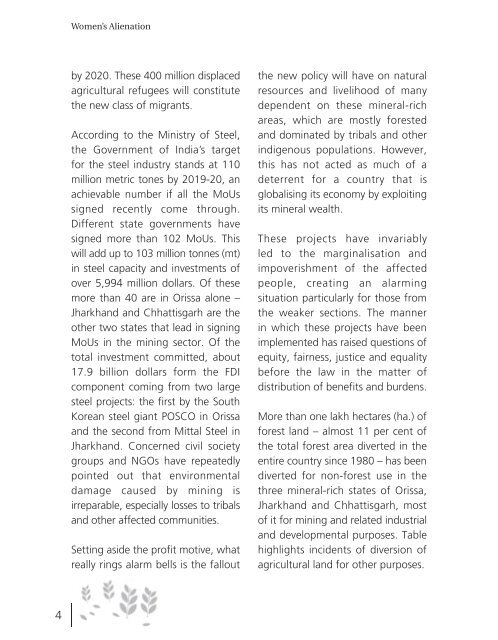om e 's Ali a - Land ss De elo en - Friedrich-Ebert-Stiftung, India Office
om e 's Ali a - Land ss De elo en - Friedrich-Ebert-Stiftung, India Office
om e 's Ali a - Land ss De elo en - Friedrich-Ebert-Stiftung, India Office
Create successful ePaper yourself
Turn your PDF publications into a flip-book with our unique Google optimized e-Paper software.
4<br />
W<strong>om</strong><strong>en</strong>’s <strong>Ali</strong><strong>en</strong>ation<br />
by 2020. These 400 million displaced<br />
agricultural refugees will constitute<br />
the new cla<strong>ss</strong> of migrants.<br />
According to the Ministry of Steel,<br />
the Governm<strong>en</strong>t of <strong>India</strong>’s target<br />
for the steel industry stands at 110<br />
million metric tones by 2019-20, an<br />
achievable number if all the MoUs<br />
signed rec<strong>en</strong>tly c<strong>om</strong>e through.<br />
Differ<strong>en</strong>t state governm<strong>en</strong>ts have<br />
signed more than 102 MoUs. This<br />
will add up to 103 million tonnes (mt)<br />
in steel capacity and investm<strong>en</strong>ts of<br />
over 5,994 million dollars. Of these<br />
more than 40 are in Ori<strong>ss</strong>a alone –<br />
Jharkhand and Chhattisgarh are the<br />
other two states that lead in signing<br />
MoUs in the mining sector. Of the<br />
total investm<strong>en</strong>t c<strong>om</strong>mitted, about<br />
17.9 billion dollars form the FDI<br />
c<strong>om</strong>pon<strong>en</strong>t c<strong>om</strong>ing fr<strong>om</strong> two large<br />
steel projects: the first by the South<br />
Korean steel giant POSCO in Ori<strong>ss</strong>a<br />
and the second fr<strong>om</strong> Mittal Steel in<br />
Jharkhand. Concerned civil society<br />
groups and NGOs have repeatedly<br />
pointed out that <strong>en</strong>vironm<strong>en</strong>tal<br />
damage caused by mining is<br />
irreparable, especially lo<strong>ss</strong>es to tribals<br />
and other affected c<strong>om</strong>munities.<br />
Setting aside the profit motive, what<br />
really rings alarm bells is the fallout<br />
the new policy will have on natural<br />
resources and livelihood of many<br />
dep<strong>en</strong>d<strong>en</strong>t on these mineral-rich<br />
areas, which are mostly forested<br />
and d<strong>om</strong>inated by tribals and other<br />
indig<strong>en</strong>ous populations. However,<br />
this has not acted as much of a<br />
deterr<strong>en</strong>t for a country that is<br />
globalising its econ<strong>om</strong>y by exploiting<br />
its mineral wealth.<br />
These projects have invariably<br />
led to the marginalisation and<br />
impoverishm<strong>en</strong>t of the affected<br />
people, creating an alarming<br />
situation particularly for those fr<strong>om</strong><br />
the weaker sections. The manner<br />
in which these projects have be<strong>en</strong><br />
implem<strong>en</strong>ted has raised questions of<br />
equity, fairne<strong>ss</strong>, justice and equality<br />
before the law in the matter of<br />
distribution of b<strong>en</strong>efits and burd<strong>en</strong>s.<br />
More than one lakh hectares (ha.) of<br />
forest land – almost 11 per c<strong>en</strong>t of<br />
the total forest area diverted in the<br />
<strong>en</strong>tire country since 1980 – has be<strong>en</strong><br />
diverted for non-forest use in the<br />
three mineral-rich states of Ori<strong>ss</strong>a,<br />
Jharkhand and Chhattisgarh, most<br />
of it for mining and related industrial<br />
and dev<strong>elo</strong>pm<strong>en</strong>tal purposes. Table<br />
highlights incid<strong>en</strong>ts of diversion of<br />
agricultural land for other purposes.


